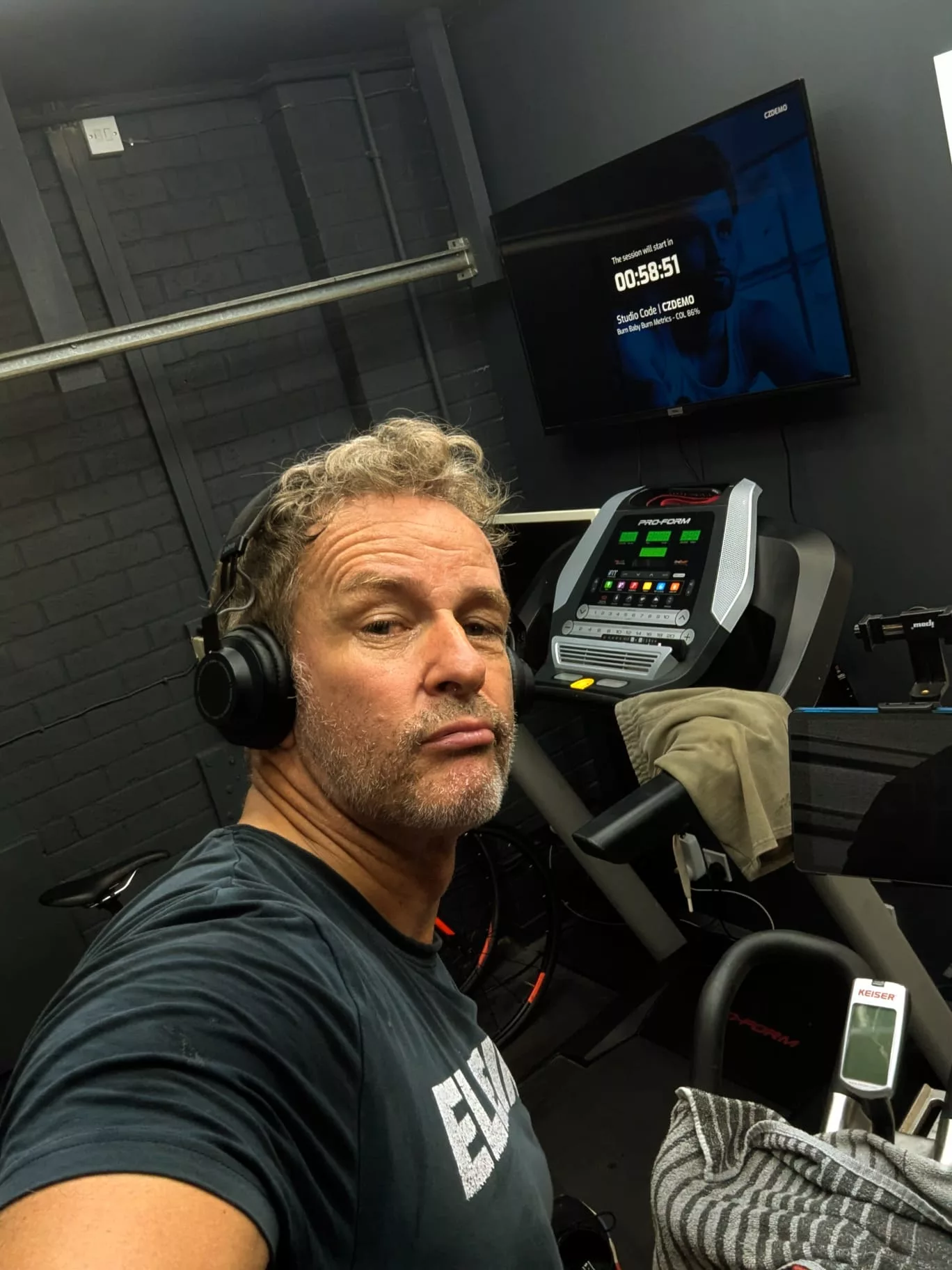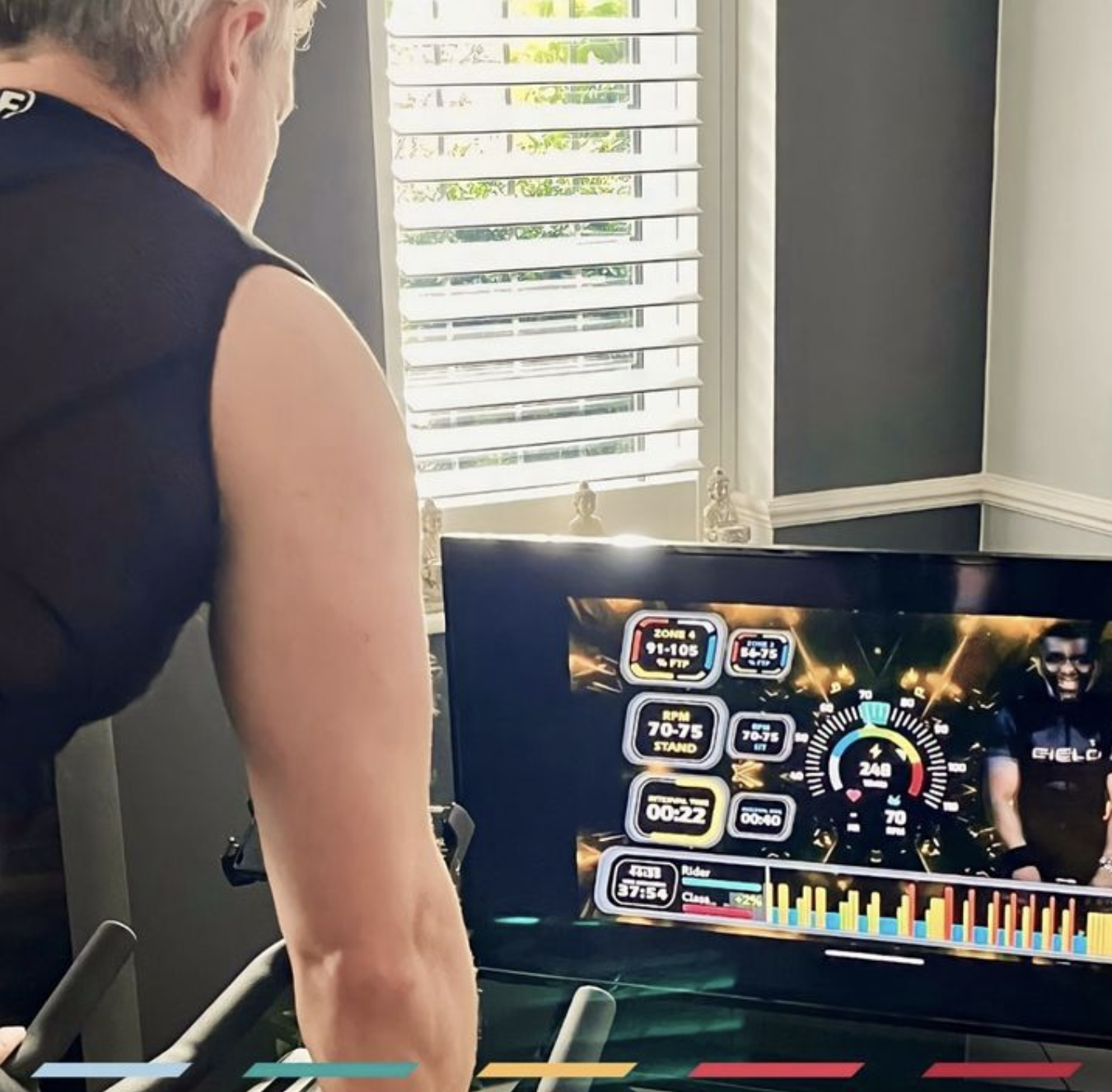1. Build Muscle
Cycling is a serious leg workout, and your quads, hamstrings, and glutes are sure to respond by building new muscle fibers to adapt. Although cycling at low resistance will slowly build muscles, you can maximize the gains and build muscle faster by riding uphill, riding in higher gears, or including sprint intervals in your workout.
2. Cut Fat
Low intensity, aerobic, and consistent exercise is one of the most effective ways to lose body fat. Cycling for an hour or so each day is plenty to begin losing fat, and you can maximize the loss by heading into a training section after fasting for a few hours – but be careful not to overeat at the end of the ride.
3. Strengthen Your Legs
Cycling is far more fun than lifting weights in the basement, but it can help you achieve similar strength gains in your lower body. The best way to build brute strength, particularly in your quads, is to grind away in your highest gear – but if you drop below 60 pedal strokes per minute, drop a gear so that you don’t crush your knee joints.
4. Decrease Your Stress
Many athletes point to the “runner’s high” as a zen mental
state that comes from exercise, but the same stress-free feeling can be found through cycling. Cycling forces you to regulate your breathing, breathe more deeply, and focus on the task at hand rather than the stress of other parts of your life.
5. Save Your Knees
Running, and most team sports that involves running, slowly breaks down your knee joints over time. Cycling, on the other hand, has a low impact on your knee joints and as a result is a sport you can participate even in old age. Be sure to fit your bike properly, since a seat that is too high or low can cause grinding or over extension.
6. Breath Deep
Just as you can train the muscles in your legs, you can train the muscles that expand and contract your lungs. Cycling is a great way for this because there are ample opportunities to include intervals in your workouts, or to practice cresting a hill and then keeping up the hard effort. This type of training can help to expand your lung capacity and teach you to move air more effectively.
7. Cheer Up
Even 30 minutes of cycling or other aerobic exercise per day has been demonstrated to improve your subjective mood. In addition, according to one study, people who exercise routinely have a decreased chance of falling into depression as they age.
8. Reduce Anxiety
Cycling has been shown to reduce stress levels by up to 40%, and as a result can keep feelings of anxiety at bay. By keeping your mind on the road in front of you rather than aspects of work or life that are bothering you, cycling can provided a much-needed mental break.
9. Stretch Yourself
The motion of cycling forces you to extend specific muscles in your lower body that don’t often get stretched, like your glutes and hip flexors. This stretching can increase your overall range of motion and flexibility. However, it’s also important to remember to stretch these muscles after rides so they don’t tighten up after expanding.
10. Sleep Better
Decreases in fitness have been found to correlate with levels of insomnia in both men and women, so it’s important to stay in shape to give yourself the best possible chance of a good night’s sleep. Cycling in particular is a great way to reap exercise-induced sleep benefits since it reduces anxiety and keeps weight down, both of which are thought to contribute to insomnia.
11. Boost Your Libido
Building your cardiovascular system is a great way to increase your sex drive and counteract aging. In men, athletes can have the sex drive of non-athletes up to five years younger and one study found that men over 50 who cycle at least three hours a week are 30% less likely to experience impotence. In women, cardiovascular exercise can delay menopause by up to several years.
12. Heart Healthy
Hopping on a bike can drastically cut your risk of heart disease. One study found that cycling regularly can decrease your chance of developing heart problems by 50%, while another study found that those who ride just 20 miles per week have half the heart disease risk as people who don’t exercise.
13. Work Those Lungs
Regular cardiovascular exercise can help to keep your lungs healthy by teaching them to move air more efficiently. Breathing hard actually forces the muscles that expand and contract your lungs to work harder, which can decrease your risk of losing lung function as your age.
14. Improve Your Cholesterol
Aerobic exercise, like cycling, is one of the best ways to boost your HDL cholesterol – the good cholesterol – and decrease your LDL cholesterol – the bad cholesterol. Just two months of regular cycling at an intensity that raises your heart rate, but doesn’t leave you breathless, is enough to raise your HDL cholesterol by 5%.
15. Fight Cancer
Exercise in general can reduce your risk of cancer, but studies have honed in on cycling in particular as one of the best sports to reduce cancer risk. One study in particular looked at bike commuters, and found that cycling to work can reduce your chances of developing cancer by 45.
16. Boost Your Brain Power
Cycling doesn’t just build blood vessels in your leg muscles – it also builds them in your brain. As a result, hopping on a bike regularly can improve blood flow through your brain which can help replenish the neurons involved in thought processing and memory.
17. Eat Frequently
Cycling can burn through your body’s fat and sugar reserves quickly, requiring you to eat small portions frequently to replenish your energy during long rides. That same habit of eating small portions frequently, rather than stomach ache-inducing large portions all at once, can help your digestive tract function more smoothly off the bike, too.
18. Improve Your Blood Pressure
Any physician will tell you that high blood pressure is a risk factor for having a heart attack. They’ll also tell you that cycling is one of the best exercises for lowering your blood pressure since it helps your body circulate blood from your legs back to your heart.
19. Boost Your Brain Power
Cycling doesn’t just build blood vessels in your leg muscles – it also builds them in your brain. As a result, hopping on a bike regularly can improve blood flow through your brain which can help replenish the neurons involved in thought processing and memory.
20. Eat Frequently
Cycling can burn through your body’s fat and sugar reserves quickly, requiring you to eat small portions frequently to replenish your energy during long rides. That same habit of eating small portions frequently, rather than stomach ache-inducing large portions all at once, can help your digestive tract function more smoothly off the bike, too.
21. Improve Your Blood Pressure
Any physician will tell you that high blood pressure is a risk factor for having a heart attack. They’ll also tell you that cycling is one of the best exercises for lowering your blood pressure since it helps your body circulate blood from your legs back to your heart.
22. Boost Your Brain Power
Cycling doesn’t just build blood vessels in your leg muscles – it also builds them in your brain. As a result, hopping on a bike regularly can improve blood flow through your brain which can help replenish the neurons involved in thought processing and memory.
23. Eat Frequently
Cycling can burn through your body’s fat and sugar reserves quickly, requiring you to eat small portions frequently to replenish your energy during long rides. That same habit of eating small portions frequently, rather than stomach ache-inducing large portions all at once, can help your digestive tract function more smoothly off the bike, too.
24. Improve Your Blood Pressure
Any physician will tell you that high blood pressure is a risk factor for having a heart attack. They’ll also tell you that cycling is one of the best exercises for lowering your blood pressure since it helps your body circulate blood from your legs back to your heart.
25. Look Younger
A study from Stanford University found that cycling regularly can reduce signs of aging by protecting your skin from harmful UV rays. The secret is that increased circulation allows your skin cells to gain nutrients and flush out toxins – just remember to lather on the sun tan lotion when you go out for a ride.
26. Regulate Your Digestion
Cycling also works the muscles inside your body – the ones surrounding your digestive tract. Cyclists have more frequent bowel movements. That may not seem like a benefit, but it actually reduces feelings of being bloated, can result in softer stools that are easier to pass, and can reduce your risk of digestive tract cancers.
27. Keep Disease At Bay
Aerobic exercise can be a significant boost to your immune system thanks to the boost in circulation it provides. One study found that people who exercised five days a week were more than 40% less likely to get the common cold compared to people who didn’t exercise, and when they did get sick they reported symptoms as being 30% less severe compared to non-athletes.
28. Improve Bone Structure
Resistance exercises are one of the best ways to improve bone density and fight osteoporosis as you age. Pushing and pulling on the pedals on the bike works the muscles in your legs, which in turn work the bones and signal your body to keep up bone structure.
29. Live Longer
By reducing your risk of some of the most common killers – car accidents, heart and lung disease, and cancer, cycling can actually help to stretch your lifespan. Numerous studies looking directly at lifespan have found that cyclists tend to live longer than non-athletes, by an average of an extra five years for men and four years for women.
30. Treat Arthritis
Cycling involves a low impact motion that makes it a great option to strengthen muscles even when most other sports cause pain. One recent study found that because of this, cycling can both slow down the development of arthritis and reduce its effects on patients who experience arthritis pain in their knees.
31. Your Newborn Will Thank You
Exercising during pregnancy has a number of benefits for both mothers and their newborns. Several studies have found that exercise can reduce the risk of caesarean sections and dangerous complications during childbirth, like preeclampsia. Children of parents who exercise also have a 50% lower risk of obesity.
32. Wake Up
Studies have found a strong link between regular exercise and reduced fatigue. In one example, study participants who cycled at low intensity for 20 minutes daily reported feelings of fatigue 65% less often than participants who did not exercise. While the mechanism for this isn’t clear, researchers believe it may be because the stimulation provided to the nervous system lasts longer than the workout itself.
33. Improve Posture
Correct posture is a big deal when cycling. It affects not only comfort during long rides, but also speed on the road and your risk for developing injury. While developing good posture on the bike takes some practice, that posture improvement will translate to all aspects of your life and can reduce your risk of back pain.
34. Injury Prevention
For non-cyclists, adding a day or more of cycling per week can go a long way towards preventing injury. For starters, simply switching out your normal sport for cycling can help to prevent overuse injuries. In addition, cycling targets and stretches specific muscles like the hip flexors and glutes that many other sports, like running, can stress.
35. Cross-Training Is Key
There are a ton of benefits to trading out your normal sport for a day of cycling once a week or more. Cycling can teach aerobic efficiency because of the nature of spinning your legs at a high rate, as well as provide an alternative to the monotony of training a single sport day in and day out.
36. Recover From Injury
Taking up cycling can be a great way to keep in shape
while fighting injury that affects another sport. Peddling uses different muscles than running and many team sports and is low impact on joints and other sensitive areas, so there’s a good chance pre-existing injuries won’t be sensitive to cycling.
37. Tailor Your Intensity
Bikes come with a series of gears that make it easy to choose the intensity of workout you want. Have a rest day? Go with an easy gear. Looking for a resistance training workout or to reap the benefits of building strength in your legs? Drop the chain into your most difficult cog.
38. Build Explosive Strength
Racing bikes takes explosive power in your legs, since the pack can break away at any moment and you must be able to reel them in quickly. That same lower body strength can also help you accelerate from a run to a sprint, making you an asset player in any other sport.
39. Improve Your Endurance
Cycling, especially over long distances, takes grit and endurance. It requires your legs to be able to meter out power steadily, and to train your ability to recover quickly. And that lower body endurance isn’t specific to biking – you’ll find yourself lasting longer on runs and in team sports as well.
40. Practice At The Redline
In any sport, the difference between good athletes and great athletes is the ability to recover quickly after a hard, draining effort. Cycling can help your muscles adapt to hard efforts and active recoveries, which can boost your fitness and performance in any sport.
41. Get Faster
Cycling can make you a faster runner thanks to the high cadence of pedaling. The best runners have cadences of 180 steps per minute, which is difficult to achieve for many runners. But cycling forces you to aim for 90 large rotations per minute, which teaches your feet and legs to turn over quickly.
42. Train Without Injury
Any sport that involves running can wear down your joints if you’re practicing every day and increase your risk of injury, but every day without practice your fitness is at risk. Cycling as a form of cross-training can allow you to train with a low injury risk because it has a very low impact on your knees and hips.
43. Build Aerobic Capacity
For any sporting events that last longer than a minute, your aerobic capacity – your body’s ability to move oxygen to your muscles – defines how long you can play at your best and has been directly linked to performance in soccer. Cycling is
one of the best exercises to improve your aerobic capacity because it combines endurance with intervals of hard efforts.
44. Stay In Shape Through The Winter
Many runners fall out of shape during the winter months because they’re hesitant to go outside in cold and wet weather. But cycling can easily be done inside by putting your bike on a trainer stand, which mimics the feeling of biking on the road and can help you stay in shape ahead of nice spring riding weather.
45. Get Competitive
Cycling can be a fun and welcoming introduction to the world of competitive sports, since there are many races that cater to beginners and pros alike. Racing can in turn encourage you to become a better cyclist or athlete in another sport, which only enhances many of the health, social, and exercise benefits from cycling.
46. Balance Better
Bikes don’t simply stay upright by themselves, so the simple act of cycling and focusing on keeping the bike steady teaches your body and mind to balance. The resulting improvement in balance can rub off on every other movement you make throughout the day, of which balance is an important and often underrated element.
47. Build Mental Fortitude
All sports are mentally demanding, and cycling is a great way to train for that. Long hours of solitude, freezing your fingers off during a winter ride, or dripping water from your whole body after riding through a rainstorm all build mental fortitude that can help carry you through any challenge, whether in sport or in life.
48. Improve Reflexes
Situations can change fast on the road. In a race, changes in speed can be sudden, while even during daily rides it’s important to be able to shift and clamp down on the breaks quickly. Because of this, cycling can help you build reflexes in your hands and legs that can increase your quickness in all parts of your life.
49. Snack More
Eat more salt? Probably not what any non-athlete would hear from their doctor, but increasing salt intake can actually be beneficial for frequent cyclists to avoid hyponatremia during long rides. That means getting to enjoy more of the snacks you love that aren’t necessarily the healthiest.
50. Drink More Beer
Let’s face it, many cyclists are just in it for the beer. Finishing off a big ride with a beer is an essential part of the celebration and recovery. And best of all, cycling will help your body burn the calories from that beer so you don’t have to worry about gaining weight from it.
51. Have More Fun
Cycling has a ton of benefits, any of which could be motivation enough to hop on a bike. But at the end of the day, it’s the fun of cycling that will keep you coming back – ask any biker how much fun cycling is, and an hour later they’ll probably still be listing all of the cool adventures they’ve had on their bike with friends.




